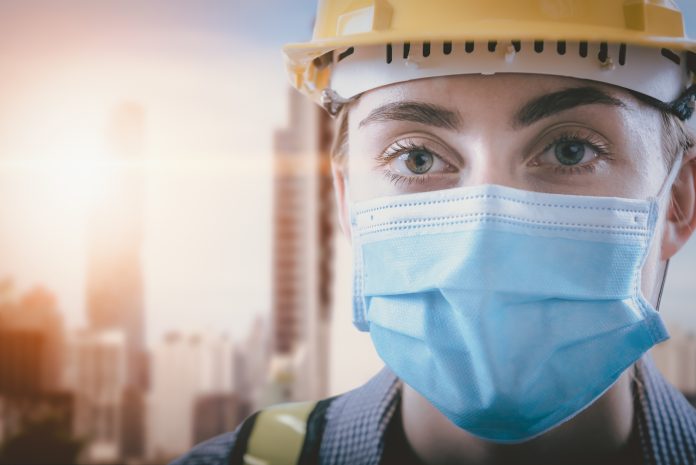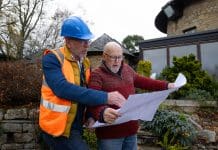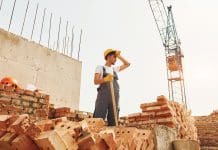A year on from the first lockdown announcement, sector professionals offer their reflections on the pandemic’s impact on the construction industry
It would be foolish to suggest that Covid-19 has had a minimal impact on the UK construction industry. The last 12 months have been interesting times for the construction and building products manufacturing sectors.
The effects were seismic, shifting the economic goalposts and changing the way we now do business.
Chris Stanley at Modern Masonry, said: “Our members were quick to react to the first lockdown with many measures put in place early on meaning near-continuous operation of block-making plants across the UK.
“Plenty of reserve stock also meant there was never any danger of a shortage with long and short lead orders being honoured, offering relief to the UK housebuilding community.”
As much of the process is automated and operated by a small, on-site workforce, adhering to government guidelines and establishing safety protocol was a relatively efficient process.
Stanley added: “Looking ahead, we know sustainable building, using passive techniques will become a major influence. Combining a fabric first approach with smart HVAC will ensure properties remain cool in the summer and warm in the winter without further contributing to climate change.
“I think built environment professionals, particularly specifiers, have had time to reflect over lockdown and consider generic terms like ‘sustainability’ and ‘value’ giving them a deeper meaning.
“I expect words like ‘longevity’, ‘locally-sourced’ and ‘circular’ will become more typical in the design brief post-Covid.”
A healthy start
Rachel Davis, director at Perega added: “We’ve noticed certain sectors of the market expanding, and others contracting. Certainly, the commercial sector has slowed as people abandon city centre offices for home working.
“However, we don’t feel this is a terminal situation and a rebound is already on the horizon, though the future landscape may look very different.
“One area we’ve seen grow significantly is healthcare work, the pandemic has thrown light onto the capacity, and capabilities, of our healthcare system. Changing demand is encouraging greater funding for new and enhanced facilities.
“We’ve definitely seen a spike in tenders over the last 12 months, which we feel is sure to rise throughout 2022.”
A breath of fresh air
The Covid-19 Pandemic hit the commercial construction industry hard, evidenced by the mass exodus from in-office to at-home working.
Erik Boyter, CEO of WindowMaster, said: We’re starting to see the green shoots of recovery emerge and a returning confidence, borne out by last week’s encouraging ONS figures which showed an encouraging, if conservative, uptick in output.
“What will certainly change is the environment we work in. The last year has seen a reappraisal of layout, particularly to limit any risk to worker welfare through future virus outbreaks.
“Further, a firmer commitment to net-zero 2050 means these reimagined spaces will need to be delivered in as an environmentally-friendly way as possible.
“As such, I think criteria such as good air quality through passive ventilation, fabric first, circular design and smart systems will become standard. Ultimately these modern methods will become a driving force behind commercial architecture, improving staff health, comfort and productivity, benefiting workforce and employer alike.”
PJ Farr, managing director at UK Connect, added: “At UK Connect, we take pride in our ‘people-first policy’.
“One of our first initiatives during the first Covid-19 lockdown was to launch an Employee Assistance Programme to offer round the clock counselling and advice on a confidential basis.
“Over and above that, we have given staff the ability to choose their working hours so employees can manage their childcare and home-schooling more easily without the pressure of set time frames.”
Powering-up the green agenda
The Covid-19 pandemic has given society plenty of time and opportunity to think long and hard about pressing, global issues, particularly climate change and how we address it.
Stuart Murphy, Founder, TPGen24, concluded: “One area which will be a key focus is our energy infrastructure, particularly as reliance on green electricity, for both commercial and residential buildings, will increase exponentially.
“Current renewable capabilities are not enough and we need to start considering a wider range of alternatives to power a no-carbon UK.
“Tidal is one resource which has been woefully under-explored and my hope is that, as we work towards a more sustainable society we reappraise its potential to deliver consistent, reliable, clean energy.”
It’s safe to say there’s a discernible degree of sanguinity in these responses. Certainly, recent ONS figures are cause for cautious optimism.
What’s for sure is that issues such as digital adoption, green building and upskilling a new generation of construction professionals has risen up the agenda.
Only time will tell, but it seems the industry’s resilience over the last 12 months, and strategic approach, has positioned it well to survive and thrive through 2021 and beyond.














